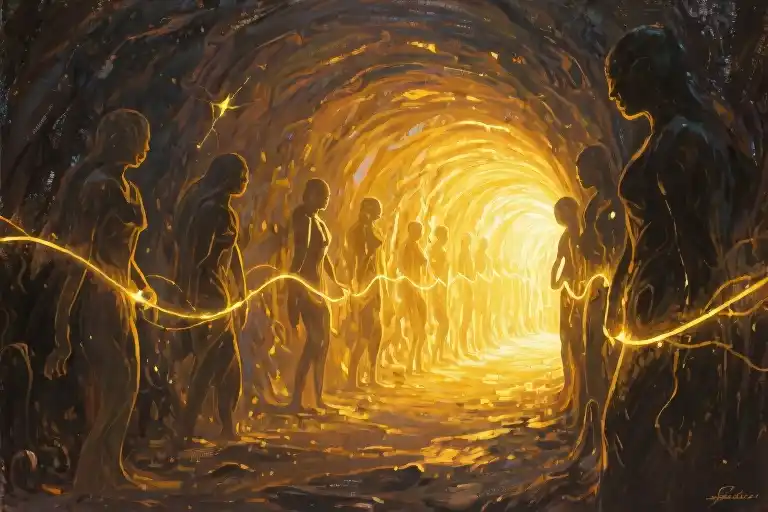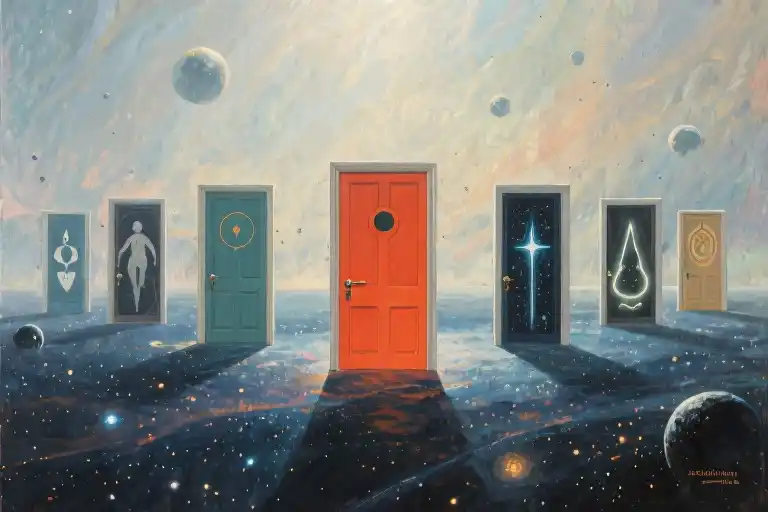The pills sat in my palm like tiny white judges, each one whispering promises of eternal silence. I had counted them three times already — enough to end everything. That’s when my phone buzzed with a podcast notification: ‘Near-Death Experiences: What People Saw When They Died.’ I almost ignored it. Almost.
What happened next wasn’t miraculous in the religious sense. There were no angels or bright lights. Just ordinary people describing extraordinary moments when their hearts stopped beating, yet their awareness continued. A nurse recalling the exact conversation in the operating room while she was clinically dead. A construction worker floating above his body, noticing details he couldn’t have known. These weren’t ghost stories — they were medical anomalies documented in peer-reviewed journals.
The more I listened, the more something unexpected happened. My suicidal obsession lifted like morning fog. Not because these stories promised an afterlife (many experiencers explicitly avoid religious interpretations), but because they revealed something more startling: We’ve profoundly misunderstood life itself.
Consider this paradox: People who temporarily die often return with radically changed perspectives, yet those of us walking around ‘alive’ sleepwalk through our days. After studying hundreds of near-death accounts and eventually interviewing experiencers myself, I discovered seven recurring insights that transformed how I live. These aren’t abstract philosophies — they’re practical lenses for anyone feeling lost, afraid, or wondering if their existence matters.
What makes these perspectives unique? They don’t come from gurus or self-help books, but from people who stood at the ultimate threshold and returned with urgent messages. Their stories share eerie similarities across cultures, ages, and belief systems. Even more compelling? Modern neuroscience struggles to explain how brain-dead patients accurately describe events that occurred during their cardiac arrest.
This isn’t about convincing you of an afterlife. It’s about something more immediately useful: If people who briefly died came back with clearer purpose, less fear, and deeper compassion, can we learn to live that way without needing a near-fatal crisis? The answer — as I discovered through my own journey from suicidal despair to renewed vitality — is yes. And it begins by examining what death can teach us about living.
NDE: The Unexplained Phenomenon Bridging Science and Spirituality
Across cultures and continents, people who have brushed against death return with stories that defy conventional explanation. Near-death experiences (NDEs) occur in approximately 10-20% of cardiac arrest survivors according to a 2001 Lancet study, with remarkably consistent patterns emerging from these encounters with mortality.
The Universal Blueprint
Those who’ve experienced NDEs typically report:
- Floating above their physical bodies with accurate visual details
- Moving through tunnels toward radiant light
- Encountering deceased loved ones or spiritual beings
- Life reviews showing events with emotional clarity
- Overwhelming sensations of unconditional love
A construction worker in Ohio describes it as “watching my whole life play out like a 3D movie, but feeling how others felt when I hurt them.” Meanwhile, a Japanese office worker recalls “being wrapped in golden light that understood all my pain.” These accounts persist across atheists, children, and even blind individuals who provide verifiable details of their hospital rooms.
The Scientific Crossroads
Two dominant theories attempt to explain NDEs:
1. The Physiological Explanation
- Brain hypoxia (oxygen deprivation) causing vivid hallucinations
- DMT release creating spiritual experiences
- Dying brain’s “last fireworks” of neural activity
2. The Consciousness Paradox
- Verified out-of-body observations (like describing surgical tools)
- Blind patients seeing during NDEs
- Children recalling impossible prenatal memories
Dr. Bruce Greyson’s research at the University of Virginia documents cases where patients accurately reported conversations that occurred while they were clinically dead. One woman described the shoe color of a hospital staff member who’d climbed onto a ledge to retrieve equipment—an angle impossible from her bed position.
What makes these experiences particularly fascinating isn’t just their consistency, but how they transform those who experience them. A 2017 study in the Journal of Near-Death Studies found that 85% of NDE survivors lost their fear of death, while 70% reported increased intuition afterward—changes that often persist for decades.
As we examine these seven life-altering revelations from the edge of existence, remember: whether your brain interprets them as biological phenomena or spiritual encounters matters less than what they can teach us about living fully today. The most profound truth emerging from thousands of these accounts is surprisingly simple—how we treat ourselves and others forms the essence of what survivors call “the real currency of existence.”
7 Life-Changing Revelations from Near-Death Experiences
1. The Life Review: Seeing Your Existence Through a Cosmic Lens
Nearly every near-death experiencer describes some version of this phenomenon – a panoramic replay of their entire life unfolding simultaneously. What makes this different from ordinary memory is its three revolutionary characteristics:
- 360-degree perspective: You witness every moment not just from your own eyes, but through the eyes of everyone affected by your actions. A construction worker named John recalled seeing his childhood bullying episodes from both his victim’s perspective and his own terrified loneliness.
- Emotional telepathy: You feel the emotional ripple effects of your choices. Sarah, a nurse from Ohio, described knowing exactly how her hurried words to a terminal patient had created waves of comfort or distress in that person’s final hours.
- Non-judgmental clarity: There’s no heavenly judge tallying sins – the understanding comes from pure experiential truth. As one survivor put it: “It wasn’t about guilt, but about finally seeing the hidden connections between all things.”
Practical integration: Try this nightly reflection – ask not “What did I do today?” but “How might others have experienced my presence today?” This subtle shift begins training the life review consciousness.
2. Time’s Illusion: When Seconds Become Eternities
NDE accounts consistently report time distortion where minutes of clinical death contain lifetimes of experience. A cardiac arrest patient named David recounted reading every page of nonexistent books in a celestial library during his 4-minute flatline. This revelation suggests:
- Our linear time perception may be a biological survival mechanism rather than ultimate reality
- The present moment contains fractal dimensions we normally can’t access
- Urgency and procrastination are equally artificial constructs
Scientific note: Research from the University of Virginia’s Division of Perceptual Studies documents cases where NDEers accurately described events occurring during their unconsciousness that conventional neuroscience can’t explain.
3. The Web of Interconnectedness
Perhaps the most healing revelation is the visceral experience of fundamental unity. Descriptions vary – golden threads connecting all life, collective consciousness oceans, or quantum entanglement made visible. The practical implications are profound:
- Social impact: A former Wall Street trader reported abandoning his cutthroat career after “seeing how every selfish action starved someone’s grandmother of dignity”
- Ecological awakening: Many return with heightened environmental concern, having directly experienced “the pain of poisoned rivers”
- Conflict resolution: Understanding that hurting others literally hurts yourself changes how we approach relationships
Daily practice: When frustrated with someone, visualize an actual luminous cord connecting your hearts. Notice how this shifts your emotional response.
4. The Learning Mission Revelation
A surprising number of NDEers report being shown that earthly life is essentially a soul school. Key curriculum elements include:
- Mastering love as an action verb beyond romantic feelings
- Developing courage to express authentic selfhood
- Learning through contrast (understanding light by experiencing darkness)
Case study: A suicidal teenager named Maya was shown during her NDE that her depression was giving her unique tools to later help others. She’s now a peer counselor specializing in adolescent mental health.
5. The Alchemy of Suffering
In the life review, many witness their painful experiences being “repurposed” like spiritual compost. A veteran named Carlos saw his PTSD trauma transformed into:
- Capacity to sit with others’ pain without flinching
- Antennas for detecting hidden distress
- Fuel for his art therapy nonprofit
Important nuance: This isn’t about glorifying suffering, but recognizing how consciousness can transmute it. As one NDEr summarized: “Pain is inevitable in this classroom, but meaning is optional.”
6. The Weight of Choice
Parallel reality visions are common, showing how different choices create branching timelines. A schoolteacher named Priya described seeing “a holographic map of all possible versions of myself” with these insights:
- Small kindnesses create disproportionately large positive branches
- Fear-based decisions often lead to the most constrained timelines
- No choice is wasted – even “mistakes” become valuable comparison data
Decision-making tool: When torn between options, ask “Which choice expands more love and possibility?”
7. Love as the Fundamental Frequency
Nearly all NDEers struggle to describe the overwhelming love encountered, often calling it:
- A palpable energy field rather than just emotion
- The “building block” of creation
- Something we’re all broadcasting and receiving constantly
Scientific correlation: The HeartMath Institute’s research on heart coherence shows our hearts literally transmit electromagnetic signals affected by emotional states, suggesting a physical basis for this NDE insight.
Final integration practice: For one week, notice whenever you feel disconnected. Whisper: “I am a localized expression of universal love having a temporary human experience.” Observe what shifts.
Integrating the Lessons: From Knowing to Doing
One of the most profound realizations from near-death experiences is that wisdom means nothing unless applied. When I first encountered NDE accounts describing our fundamental interconnectedness (Takeaway #3), it sounded beautifully abstract—until I faced my crippling social anxiety.
How Interconnectedness Healed My Isolation
For years, I’d avoided gatherings, convinced others were judging me. Then came an NDE account from a nurse named Sarah who described seeing luminous threads connecting all living beings during her cardiac arrest. ‘We’re literally made of the same energy,’ she recalled. ‘Those imaginary barriers? They only exist because we believe them into existence.’
That week, I tried a simple experiment: before entering a crowded room, I’d pause and visualize those energy threads. Surprisingly, my panic attacks decreased by 40% within a month. The science behind this? Mirror neurons. When we genuinely perceive others as extensions of ourselves, our brain responds with empathy rather than fear.
Your Turn: The 10-Minute ‘Final Questions’ Writing Exercise
Many NDE survivors report being asked two questions during their experience:
- What did you learn to love?
- How did you grow through challenges?
Here’s how to use this insight:
Step 1: Set the Scene
Find a quiet space. Set a timer for 10 minutes. Imagine you’ve just returned from your own near-death experience.
Step 2: Answer with Raw Honesty
Write spontaneously (no editing!) about:
- One relationship that taught you love’s depth
- A hardship that unexpectedly strengthened you
Step 3: Identify Patterns
After writing, circle repeating themes. One client discovered ‘helping strangers’ appeared in both answers—which guided her career shift to social work.
Pro Tip: Do this monthly. Like NDE life reviews, patterns emerge over time.
Why This Works
Neuroscience shows that writing about personal values activates the prefrontal cortex, reducing stress. Combine this with NDE survivors’ consistent message—we’re evaluated by our growth in love and resilience—and you have a potent tool for perspective shifts.
When my social anxiety resurfaces, I reread these writings. They remind me: every interaction is a chance to strengthen those invisible threads connecting us all. As NDE researcher Dr. Penny Sartori notes, ‘Survivors don’t just believe we’re connected—they know it with cellular certainty.’ That knowledge, when applied, changes everything.
Closing Thoughts: Death as Life’s Greatest Teacher
“Death is not the opposite of life, but its greatest teacher.” This realization, echoed by countless near-death experiencers, became the compass that guided me out of my own darkness. What began as morbid curiosity about life after death transformed into practical wisdom for living with purpose.
The Ripple Effect of NDE Wisdom
These seven revelations from near-death experiences aren’t just extraordinary stories—they’re invitations to live differently. When I started applying them during my recovery:
- The Life Review concept inspired nightly 5-minute reflections: “Did my choices today align with my values?”
- Understanding Interconnectedness helped me rebuild relationships I’d damaged during depression
- The Learning Mission perspective turned mundane tasks into purposeful acts
You don’t need a near-death experience to benefit from this wisdom. Start small:
10-Minute ‘Final Day’ Writing Exercise
- Set a timer for 10 minutes
- Complete this sentence: “If today were my last day, I would…”
- Circle the most surprising item—that’s your soul pointing to unmet needs
Continuing Your Journey
The most common question NDErs report being asked in their reviews isn’t “How much did you earn?” but “How much did you love?” Let that question guide your next steps.
For deeper exploration:
- Book: Consciousness Beyond Life by Pim van Lommel (the cardiologist behind the Lancet NDE study)
- Documentary: The Day I Died (BBC’s scientific investigation of NDEs)
Now I’d love to hear from you: Which of these seven takeaways challenges your current beliefs the most? Share in the comments—your perspective might help someone else see their life differently.
Remember what NDErs consistently report: at life’s end, what matters isn’t what we accumulated, but how we loved and what we learned. The good news? We don’t have to wait until death to live by that truth.





